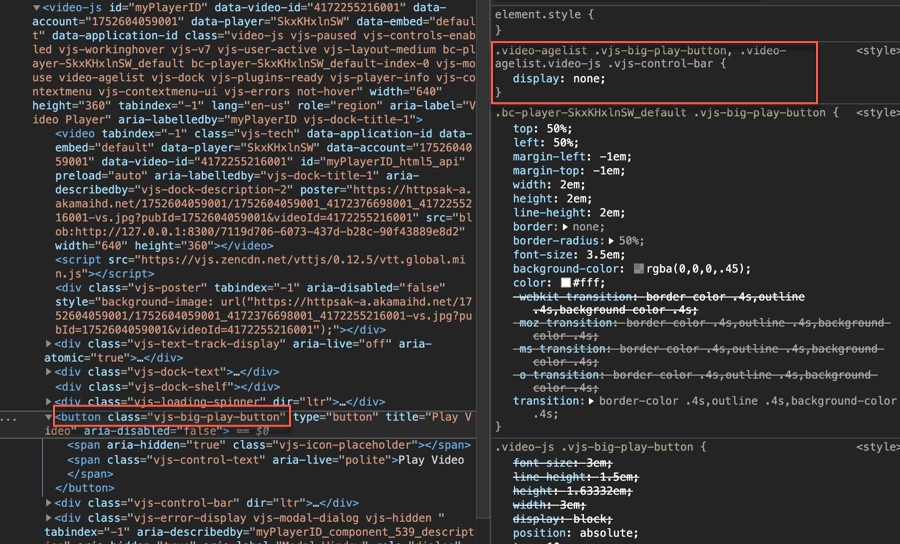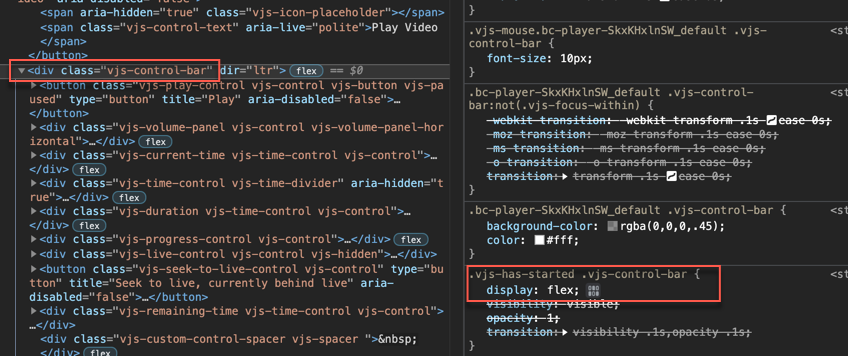Player example
This example displays an overlay and hides the player controls and play button. When the user confirms their age by clicking on the overlay text, the controls are displayed and the video plays. Test the functionality by clicking on the text.
See the Pen 18149-brightcove-player-sample-age-gate by Brightcove Learning Services (@rcrooks1969) on CodePen.
Source code
View the complete solution on GitHub.
Using the CodePen
Here are some tips to effectively use the above CodePen:
- Toggle the actual display of the player by clicking the Result button.
- Click the HTML/CSS/JS buttons to display ONE of the code types.
- Later in this document the logic, flow and styling used in the application will be discussed in the Player/HTML configuration, Application flow and Application styling sections. The best way to follow along with the information in those sections is to:
- Click the EDIT ON CODEPEN button in the CodePen and have the code available in one browser/browser tab.
- In CodePen, adjust what code you want displayed. You can change the width of different code sections within CodePen.
- View the Player/HTML configuration, Application flow and/or Application styling sections in another browser/browser tab. You will now be able to follow the code explanations and at the same time view the code.
Development sequence
Here is the recommended development sequence:
- Use the In-Page embed player implementation to test the functionality of your player, plugin and CSS (if CSS is needed)
- Put the plugin's JavaScript and CSS into separate files for local testing
- Deploy the plugin code and CSS to your server once you have worked out any errors
- Use Studio to add the plugin and CSS to your player
- Replace the In-Page embed player implementation if you determine that the iframe implementation is a better fit (detailed in next section)
For details about these steps, review the Step-by-Step: Plugin Development guide.
iframe or In-Page embed
When developing enhancements for the Brightcove Player you will need to decide if the code is a best fit for the iframe or In-Page embed implementation. The best practice recommendation is to build a plugin for use with an iframe implementation. The advantages of using the iframe player are:
- No collisions with existing JavaScript and/or CSS
- Automatically responsive
- The iframe eases use in social media apps (or whenever the video will need to "travel" into other apps)
Although integrating the In-Page embed player can be more complex, there are times when you will plan your code around that implementation. To generalize, this approach is best when the containing page needs to communicate to the player. Specifically, here are some examples:
- Code in the containing page needs to listen for and act on player events
- The player uses styles from the containing page
- The iframe will cause app logic to fail, like a redirect from the containing page
Even if your final implementation does not use the iframe code, you can still use the In-Page embed code with a plugin for your JavaScript and a separate file for your CSS. This encapsulates your logic so that you can easily use it in multiple players.
API/Plugin resources used
| API Methods | API Events | Brightcove Player Plugins |
|---|---|---|
| removeClass() | loadedmetadata | videojs-overlay |
| play() |
Player/HTML configuration
This section details any special configuration needed during player creation. In addition, other HTML elements that must be added to the page, beyond the in-page embed player implementation code, are described.
Player configuration
The Overlay plugin was configured in Studio as follows:
Name:
overlay
Options:
{
"content": "<strong>Default overlay content</strong>",
"overlays" : [{
"content" : "<div id='ageGateButton'>By clicking here you certify that you are over 18 years old</div>",
"start" : "loadedmetadata",
"end" : "play"
}]
}
Other HTML
No other HTML elements are added to the page.
Application flow
The basic logic behind this application is:
- Display clickable overlay text.
- Hide the player controls and the play button.
- When the user clicks on the overlay text, then remove the overlay and start video playback.
Display overlay text
The overlay plugin is displayed as soon as the video is loaded. The age gate text is defined within the overlay plugin. Here, we have also assigned the text with an id attribute, so that we can reference it within our JavaScript code.
Add an event listener
Find the code which is labeled:
// +++ Set up listening for when the user clicks the age verification text +++
To the age gate text, add an event listener for the click event. When a user selects the age gate text, remove the overlay and start video playback.
Application styling
The CSS positions the overlay and the age gate text within the overlay. There is also a style to hide the control bar and play button.
Hiding player controls
Let's take a closer look at how we used CSS to hide the big play button and the control bar. For an introduction about changing the appearance of the Brightcove Player, see the Customizing Player Appearance guide.
First, let's change the style to hide the player's big play button.
- In the Chrome browser, open the Developer Tools.
- Right click on the player and select Inspect Element.
- In the Elements section of the Developer Tools, select the HTML associated with the big play button.
- In the Styles section, you can see that the original
displayproperty with a value ofblockis set on the<div>element.
Hide Big Play Button - When overriding CSS values, more specific styles win over less specific ones. Since elements have the lowest specificity value, we can override the display property by simply specifying the
vjs-big-play-buttonclass. -
Look at our CSS for the big play button below. In this example, we are saying select all elements with a class name of
vjs-big-play-buttonwhich are decendents of the element with class name ofvideo-agelist. Remember that in the JavaScript code, we added thevideo-agelistclass to the player.video-agelist.video-js .vjs-control-bar, .video-agelist .vjs-big-play-button { display: none; }
Next, let's change the style to hide the player's control bar.
- In the Elements section of the Developer Tools, select the HTML associated with the player control bar.
- In the Styles section, you can see that the original
displayproperty with a value offlexis set with three class attributes in the selector.
Hide Control Bar - To override the style for the control bar, we need at least three class attributes in our selector, including the
vjs-control-barclass. - Look at our CSS for the control bar below. In this example, we are saying select all elements with a class name of
vjs-control-barwhich are decendents of the element with both a class name ofvideo-agelistand a class name ofvideo-js..video-agelist.video-js .vjs-control-bar, .video-agelist .vjs-big-play-button { display: none; }For more information about calculating specificity value, see the Specifics on CSS Specificity page.
Plugin code
Normally when converting the JavaScript into a Brightcove Player plugin nominal changes are needed. One required change is to replace the standard use of the ready() method with the code that defines a plugin.
Here is the very commonly used start to JavaScript code that will work with the player:
videojs.getPlayer('myPlayerID').ready(function() {
var myPlayer = this;
...
});
You will change the first line to use the standard syntax to start a Brightcove Player plugin:
videojs.registerPlugin('pluginName', function(options) {
var myPlayer = this;
...
});
As mentioned earlier, you can see the plugin's JavaScript code in this document's corresponding GitHub repo: age-gate.js.
Using the plugin with a player
Once you have the plugin's CSS and JavaScript files stored in an Internet accessible location, you can use the plugin with a player. In Studio's PLAYERS module you can choose a player, then in the PLUGINS section add the URLs to the CSS and JavaScript files, and also add the Name and Options, if options are needed.
